#elizabeth alexandra mary windsor II of house windsor
Text
do not ask where i was on september 8th, 2022
3 notes
·
View notes
Text
We celebrate the memory of this glorious event, 71 years ago today.

A lovely young Queen heralds the beginning of a new Elizabethan era.
#Her Majesty#Queen Elizabeth II#Coronation#2 June 1953#UK#tradition#Prince Philip#monarchy#Westminster Abbey#brf#House of Windsor#Elizabeth Alexandra Mary#On this day
135 notes
·
View notes
Text

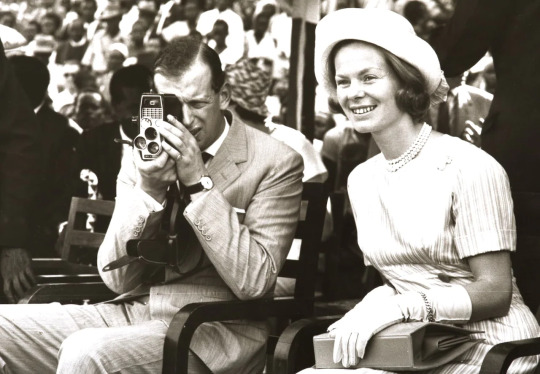
The Duke on his way to ski in Munster in the 1950s. On a previous occasion he had forgotten his passport, causing a mini crisis at the airport. This time he remembered
In Uganda with the Duchess of Kent, 1962
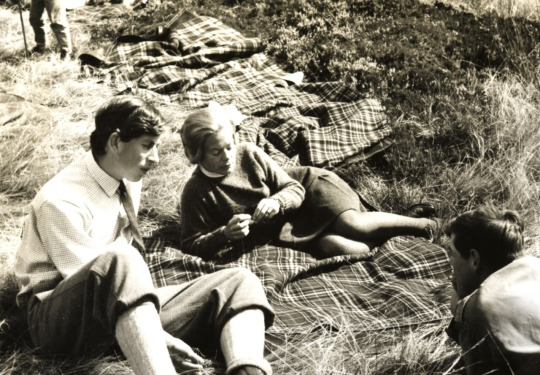
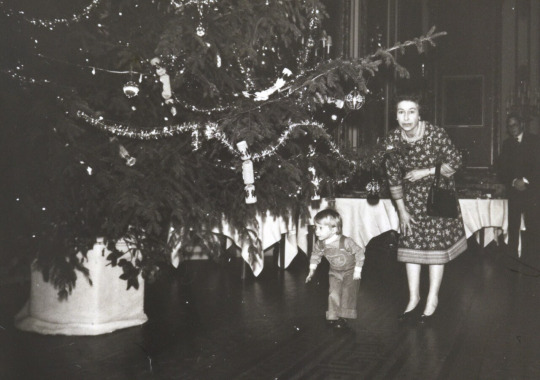
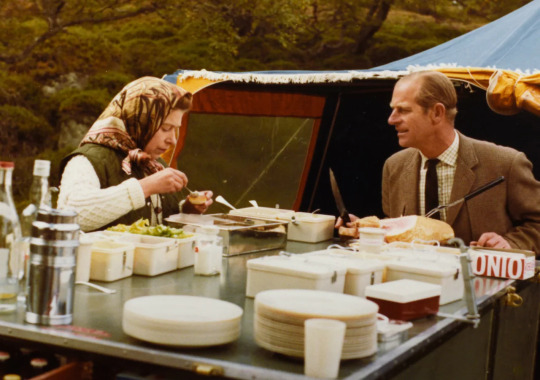
Prince Charles with the Duchess of Kent at Balmoral in about 1970. They shared an interest in music, especially opera
Christmas at Windsor Castle in about 1977: The Queen with the Earl of Ulster, and in the background the Earl’s father, the Duke of Gloucester. The Royal Family loved staying at Windsor, and in particular the moment that the Queen threw open the doors and the children rushed in to get their presents
The Queen and Prince Philip enjoying a picnic lunch at Balmoral in the 1970s
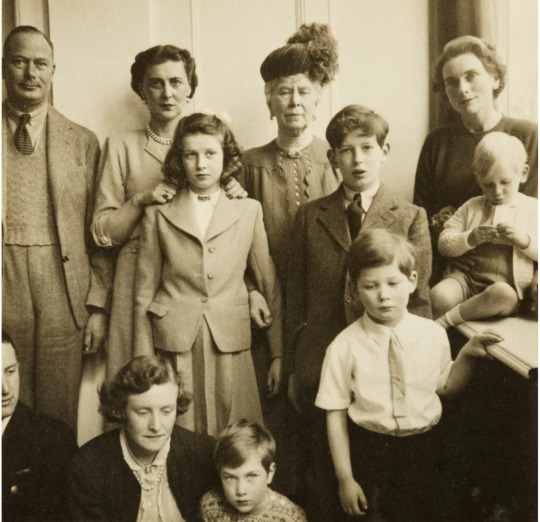
The Royal Family together. Left to right (back row) – the Duke of Gloucester, Princess Marina, Queen Mary & the Duchess of Gloucester. Middle row – Princess Alexandra, the Duke of Kent & Prince Richard of Gloucester. Front row – Princess Margaret of Hesse, Prince William of Gloucester & Prince Michael of Kent

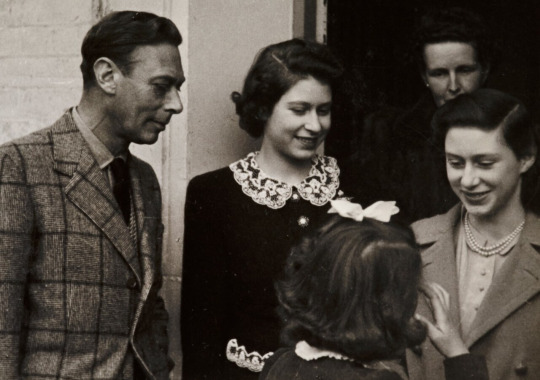
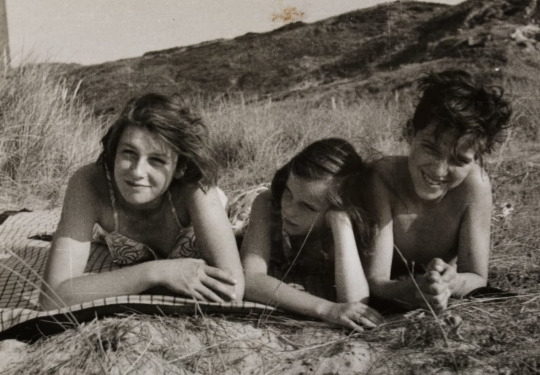
Princess Marina with her mother, Princess Nicholas of Greece, and her sister, Princess Olga. Princess Nicholas, a formidable Russian Grand Duchess, and by then a widow, lived at Psychico, a suburb of Athens. Her daughters were frequent visitors
King George VI at Coppins with Princesses Elizabeth and Margaret
Princess Alexandra (left) with cousins Helen Habsburg and Hans Veit Toerring in Norfolk
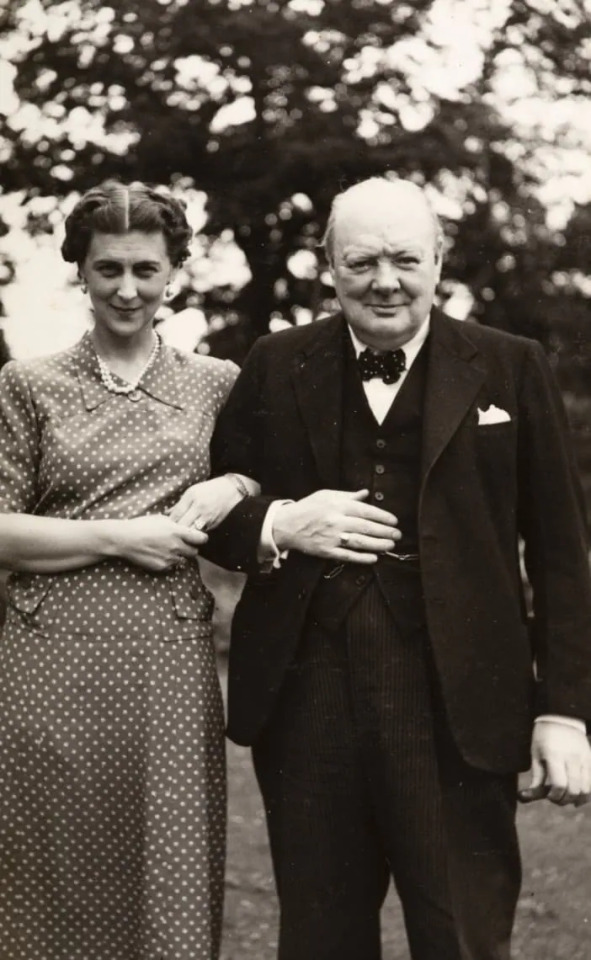
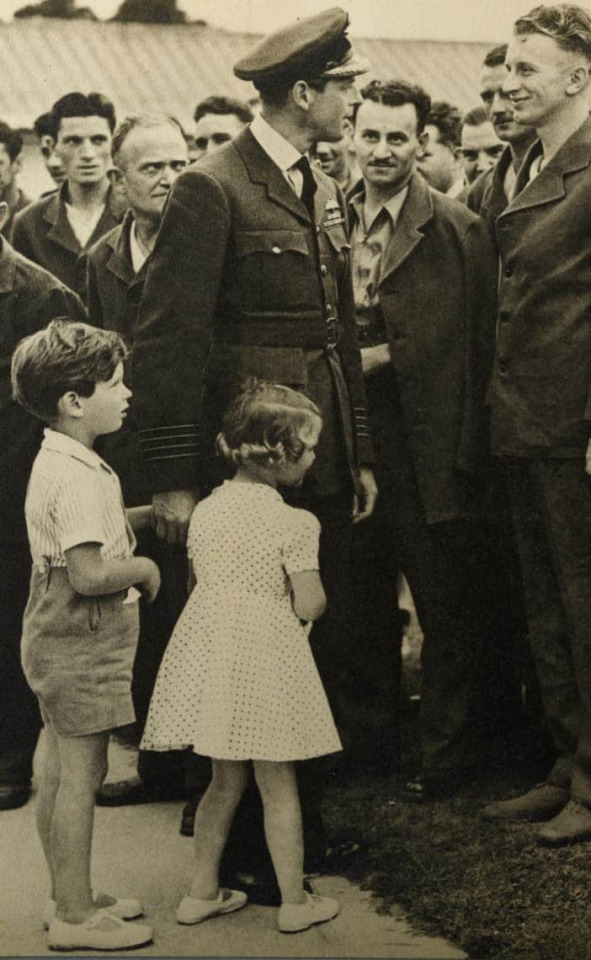
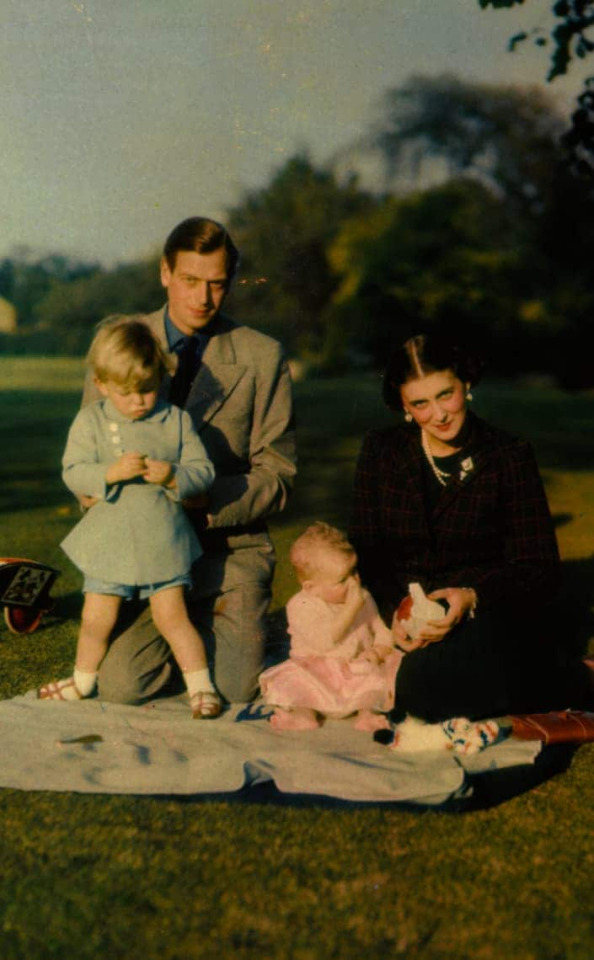
Princess Marina with Winston Churchill, who came to lunch at Coppins towards the end of the war, in 1944. ‘And who is this?’ asked the great statesman on observing the Duke, then aged nine
With his father, Prince George, and sister, Princess Alexandra
Prince Edward with his parents and sister
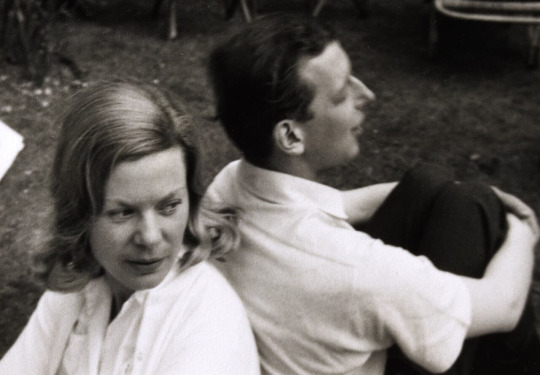
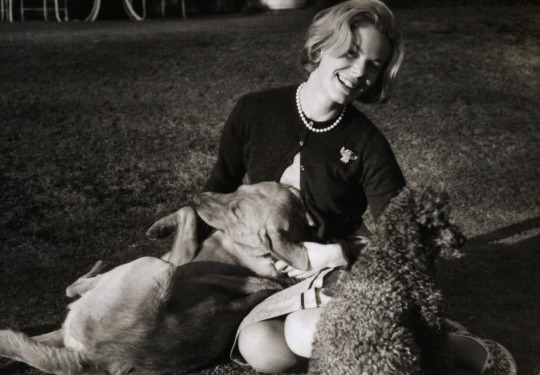
The Duke and Duchess together at Coppins in the early days of their marriage
The Duchess of Kent with her Labrador, Columbus, and her poodle, Charlie, soon after she married the Duke in 1961
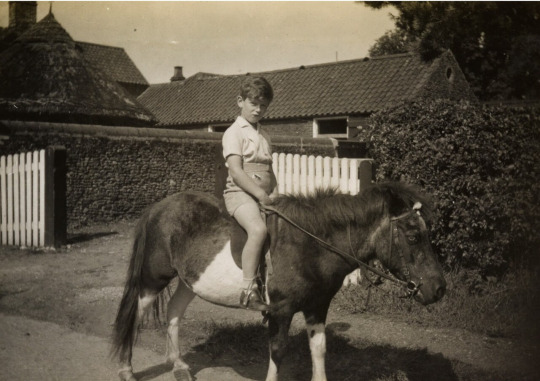
Prince Edward on a pony at Horace Smith’s riding school at Bray. The Duke found him a bit severe – he was a proper old school riding instructor who always wore highly polished boots

'I always felt I wanted to support her. That’s by far the most important thing in life': HRH The Duke of Kent, then Prince Edward, between the Queen, then Princess Elizabeth, and Princess Margaret, at Frogmore House in Windsor, 1930s

Princess Elizabeth (Queen Elizabeth II) lifting Prince Edward of Kent (Duke of Kent)
Inside the Duke of Kent's private royal family photo album
#duke of kent#duchess of kent#british royal family#queen elizabeth ii#prince philip#princess margaret#princess marina#prince george DoK
67 notes
·
View notes
Text
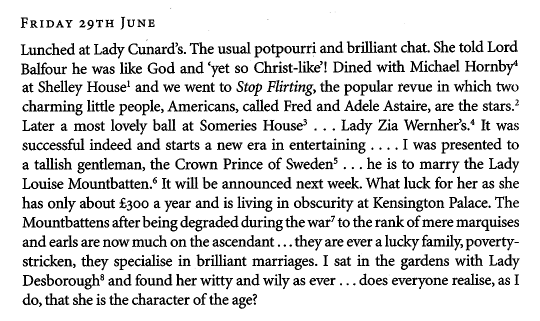
Henry ‘Chips’ Channon: The Diaries (Vol. 1), 1918-38, entry for 29th June 1923
—
Friday 29th June
Lunched at Lady Cunard’s. The usual potpourri and brilliant chat. She told Lord Balfour he was like God and ‘yet so Christ-like’! Dined with Michael Horby¹ at Shelley House² and we went to Stop Flirting, the popular revue in which two charming little people, Americans, called Fred and Adele Astaire, are the stars.³ Later a most lovely ball at Someries House⁴ ... Lady Zia Wernher’s.⁵ It was successful indeed and starts a new era in entertaining .... I was presented to a tallish gentleman, the Crown Prince of Sweden⁶ ... he is to marry the Lady Louise Mountbatten.⁷ It will be announced next week. What luck for her as she has only about £300 a year and is living in obscurity at Kensington Palace. The Mountbattens after being degraded during the war⁸ to the rank of mere marquises and earls are now much on the ascendant ... they are ever a lucky family, poverty-stricken, they specialise in brilliant marriages. I sat in the garden with Lady Desborough⁹ and found her witty and wily as ever ... does everyone realise, as I do, that she is the character of the age?
—
1. Michael Charles St John Hornby (1899-1987), son of St John Hornby, was the founding partner of WH Smith.
2. The Hornby family’s house in Chelsea.
3. Frederick Austerlitz (1899-1987), who took the name Fred Astaire, was an American actor, dancer and singer who achieved worldwide fame in the 1930s in a series of Hollywood musicals renowned for their dance routines; and his sister Adele Marie (1896-1981), with whom he began a vaudeville act as children as 1905, when they changed their name to Astaire. By 1923 they had a Broadway act, which they were touring in London.
4. A Crown State property rented by the Wernhers in Regent’s Park, designed by John Nash and damaged by bombing during the Second World War. It was demolished in 1958.
5. Countess Anastasia Mikhailovna of Torby (1892-1977), elder daughter of the Grand Duke Michael Mikhailovich of Russia, and therefore a great-granddaughter of Tsar Nicholas I. She married, in 1917, Harold Wernher (1893-1973), later 3rd Bt. She was granted the rank and precedence of an earl’s daughter after her marriage and stopped using her Russian title, being known as Lady Zia Wernher thereafter.
6. Oscar Fredrik Wilhelm Olaf Gustaf Adolf (1882-1973), from 1950 King Gustaf VI Adolf of Sweden. He was the widower of Princess Margaret of Connaught (1882-1920), whom he had married in 1905; she was the cousin of King George V, and had died suddenly while eight months pregnant with her sixth child.
7. Louise Alexandra Marie Irene Mountbatten (1889-1965), previously Princess Louise of Battenberg, married the Crown Prince of Sweden (vide supra) in 1923, and was Queen Consort of Sweden from 1950. She was daughter of Prince Louis of Battenberg, who became 1st Marquess of Milford Haven when renouncing the German titles in 1917. She had earlier turned down proposals from King Manuel II of Portugal and had been secretly engaged to Prince Christopher of Greece, who was unable to marry her because he had no money; a second engagement was to Stuart Hill, an artist, whom she met while nursing in the Great War and who turned out to be homosexual.
8. There was a protracted debate between Lloyd George, King George V and Lord Stamfordham, the King’s private secretary, in 1917 about the titles to be bestowed on German members of the King’s family who had pledged allegiance to him and had been prepared to forfeit their German ranks. The King was cautioned against granting too many titles and to avoid bestowing any dukedoms. The Mountbatten marquessate was a compromise and their rise would indeed be unstoppable, with the surname of members of the House of Windsor becoming Mountbatten-Windsor in 1960, thirteen years after the marriage of the future Queen Elizabeth II to Philip Mountbatten.
9. Ethel ‘Ettie’ Fane (1867-1952), married in 1887 William Henry Grenfell (1855-1945), 1st Baron Desborough, a former Liberal MP who had joined the Conservatives in 1893 over his disagreement with the second Home Rule Bill for Ireland. Their three sons (qqv) predeceased them, two killed in the Great War and a third in a car crash.
#chips channon#channon diaries#1923#1920s#emerald cunard#arthur balfour#michael hornby#fred astaire#adele astaire#zia wernher#gustaf vi adolf#louise mountbatten#ettie desborough#🕰️
7 notes
·
View notes
Text

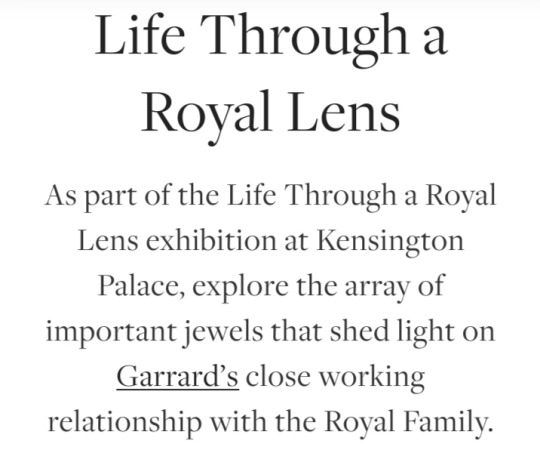
In her “accession” photographs, shot in 1952 by Dorothy Wilding, HM Queen Elizabeth II is pictured with the Girls of Great Britain and Ireland Tiara upon her head – a jewel that you might recognize because Her Majesty is seen wearing it on the front of every Bank of England banknote.
Originally the property of Queen Mary, Duchess of York, Princess of Wales and finally Queen Consort of King George V, the Girls of Great Britain and Ireland Tiara was crafted by Garrard in 1893 to be given as a wedding present from the Girls of Great Britain and Ireland committee.
Designed to be transformable, allowing it to be worn as either a necklace or coronet, over the years, Queen Mary requested that Garrard add diamonds, remove pearls, and separate the bandeau from the base so that she could wear it as a headband.
In 1947, Queen Mary gave the tiara to Princess Elizabeth as a wedding present. In 1969, now Queen Elizabeth II, she asked for the bandeau and tiara to be reunited, as it remains today.
Worn frequently by Her Late Majesty The Queen, the Girls of Great Britain and Ireland Tiara is an ongoing source of inspiration for Garrard’s designers, with the repeated pattern of diamonds encircling the base reflected in the round and geometric Windsor motif, which is a signature of the Albemarle and Fanfare jewellery collections.

The Queen’s love of brooches is legendary, and in Bob Thomas’ intimate portrait of Her Majesty at the Royal Windsor Horse Show, she is pictured wearing the Cullinan V Heart Brooch, one of several important brooches commissioned from Garrard by the Royal Family.
Showcasing the 18.80-carat heart shape Cullinan V diamond, the fifth-largest gem to be cut from the 3,106-carat Cullinan Diamond – the largest gem-quality rough diamond ever discovered – the diamond was given to Queen Mary in 1911 as a gift from the South African government.
It was originally worn by Queen Mary as part of the suite of jewellery made by Garrard for her to wear at the Delhi Durbar in 1911.
When Queen Mary died in 1953, the Cullinan V Brooch was passed to her granddaughter, Her Late Majesty Queen Elizabeth II, who was photographed wearing it throughout her reign.

The Sapphire and Diamond cluster ring worn by Catherine, Princess of Wales, formerly Duchess of Cambridge, in the 2013 portrait by her father Michael Middleton is among Garrard’s best-known creations.
Set with a magnificent 12-carat oval Ceylon sapphire, encircled by a cluster of diamonds set in 18 carat white gold, the ring was personally chosen by Lady Diana Spencer for her engagement to Prince Charles.
It became instantly famous after it was prominently showcased in an engagement shoot in 1981 that took place in the grounds of Buckingham Palace.
A new chapter in the story of Princess Diana’s engagement ring was written when, in 2010, William, Prince of Wales, formerly Duke of Cambridge, chose to propose to Catherine Middleton with the same engagement ring his father had given to Diana.
As this royal jewel, passed down through generations, takes on new meaning and sentiment upon Princess of Wales’ hand, we continue to honour this history-defining design in the 1735 collection.
Garrard’s iconic cluster setting also features prominently in the Jewelled Vault, where each one-of-a-kind creation is designed around an exceptional central stone.

A page from the scrapbook of Princess Victoria of Wales, daughter of King Edward VII and Queen Alexandra, shows photographs of Alexandra, dating from 1901, wearing a diamond crown that is much smaller than a traditional royal crown.
Crafted by Garrard in 1871 at the request of Queen Victoria, the miniature crown was designed to be worn over Queen Victoria widow’s cap.
Set with more than 1,000 diamonds and featuring alternating crosses and fleur-de-lis motifs, Garrard created the crown so that the arches could be removed.
Queen Victoria wore the Small Diamond Crown for the first time at the opening of Parliament in 1871 and frequently thereafter for state occasions.
After Queen Victoria’s death, the crown was worn by Queen Alexandra, who in turn passed it to her daughter-in-law, Queen Mary.
Today, Queen Victoria’s Small Diamond Crown is housed at the Jewel House at the Tower of London, where it is on display.
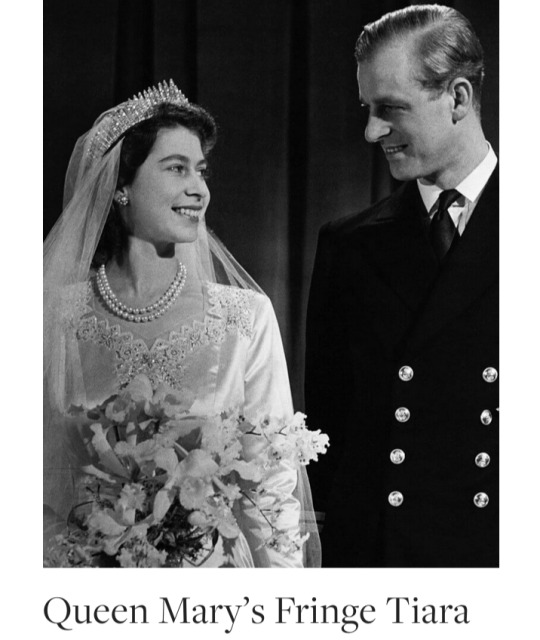
Both King George VI and HM The Queen are pictured wearing the Imperial State Crown in the Life Through a Royal Lens exhibition.
The 10th iteration of this historic jewel, the crown was crafted by Garrard in 1937 for King George VI and adjusted for The Queen ahead of her coronation in 1953.
Some of the most historic gems in the royal collection reside in this Crown Jewel, including, at the front of the crown, the Cullinan II, the second largest diamond cut from the 3,106-carat Cullinan Diamond – the largest gem-quality rough diamond ever discovered.
Above it, mounted on a diamond Maltese cross, is the Black Prince Ruby, which is not a ruby at all.
In the 16th century, it was discovered that this blood-red semi-polished stone is, in fact, a spinel, a gem that is often referred to as “the great imposter” after it was discovered that some of the most famous “rubies” seen in crown jewels around the world are, indeed, spinels.

A big moment in Garrard’s history was the recutting of the Koh-i-Noor Diamond.
This sizeable white diamond was first displayed to the public at the Great Exhibition of 1851.
In 1852, Prince Albert, who was instrumental in the creation of the Exhibition, commission Garrard to recut the diamond.
The intensely demanding cutting process lasted eight weeks and was overseen by The Duke of Wellington.
Garrard worked to create more facets to enhance its beauty; consequently, the diamond emerged as a dazzling brilliant weighing 105.6 carats.
In 1911, the Koh-i-Noor was set into Queen Mary’s Crown, newly created by Garrard for the Coronation.
Today, the fabled Koh-i-Noor Diamond (which is now only worn by a woman – if a man wears it, he will supposedly be cursed) is set at the centre of The Queen Mother’s Crown created by Garrard in 1937.

In a black-and-white photograph taken at the Delhi Durbar in 1911, held to mark the coronation of King George V and Queen Mary as Emperor and Empress of India, Queen Mary is pictured wearing the magnificent Delhi Durbar Suite.
Created by Garrard at the request of the Queen, who wanted a suite of jewels that perfectly captured the majesty of the occasion, the suite included an emerald and diamond tiara, earrings, a brooch, a stomacher, and a spectacular necklace.
Designed by Garrard in a striking circlet style, the Delhi Durbar necklace is set with eight large cabochon emeralds known collectively as the Cambridge Emeralds, with a pendant suspended beneath set with a ninth Cambridge Emerald.
In 1912, Garrard made slight alterations to the necklace, making the emerald pendant detachable and adding a second removable pendant showcasing the 8.80-carat marquise cut Cullinan VII diamond.
Queen Mary regularly wore the necklace and the other jewels in the parure for the rest of her life, after which they became the property of Her Late Majesty Queen Elizabeth II, who inherited the Delhi Durbar Necklace in 1953 and had worn it on many occasions.
The Delhi Durbar Tiara, meanwhile, was given by Her Late Majesty The Queen to Camilla, Queen Consort, after her marriage to His Majesty King Charles III.

Commissioned by Queen Mary in 1919, the Fringe Tiara was crafted by Garrard in the fashionable Russian style reminiscent of a kokoshnik and designed to be convertible so that it could be worn as either a tiara or a necklace.
Queen Mary gave the tiara to her daughter-in-law, Queen Elizabeth, later the Queen Mother, who was pictured wearing it in Cecil Beaton’s whimsical portrait.
Queen Elizabeth in turn loaned it to her daughter, Her Late Majesty Queen Elizabeth II, then Princess Elizabeth, to wear for her wedding to Philip Mountbatten in 1947 as her “something borrowed.”
In 1974, the Queen Mother loaned the Fringe tiara for another royal wedding, that of her granddaughter Princess Anne.
Most recently, it was worn by Princess Beatrice on the occasion of her wedding to Edoardo Mapelli Mozzi in 2020.

Originally created by Garrard in 1870 for Florence, Lady Poltimore, the 2nd Baron of Poltimore, the Poltimore Tiara was not publicly known until it was acquired by Princess Margaret prior to her engagement to Antony Armstrong-Jones in 1959.
Featuring elegant diamond scrolls evocative of flora – an enduring source of inspiration during the Victorian era in which it was made – it quickly became one of the Princess’s most prized possessions.
In the ensuing years, both Margaret and the towering jewel were regularly in the spotlight, including, most famously, the photograph on show as part of the Life Through a Royal Lens exhibition featuring the Princess wearing the Poltimore Tiara in the bathtub.
#Queen Elizabeth II#HM Queen Elizabeth II#Girls of Great Britain and Ireland Tiara#King George V#Queen Mary#Cullinan V Heart Brooch#Sapphire and Diamond Cluster Engagement Ring#Lady Diana Spencer#Diana Princess of Wales#Catherine Middleton#Catherine Princess of Wales#Queen Victoria#Prince Albert#Small Diamond Crown#Queen Alexandra#Imperial State Crown#Cullinan II#Black Prince Ruby#Koh-i-Noor Diamond#Great Exhibition of 1851#Delhi Durbar Suite#Cambridge Emeralds#Cullinan VII#Delhi Durbar Tiara#Fringe Tiara#Poltimore Tiara#Princess Margaret#British Royal Family#Dorothy Wilding#Tower of London
53 notes
·
View notes
Text
ECOZONE LIFESTYLE PAYS TRIBUTE TO HER MAJESTY QUEEN ELIZABETH II
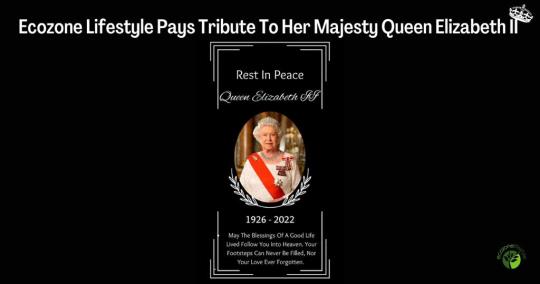
‘08-September-2022’- BALMORAL CASTLE, UNITED KINGDOM
‘’The Queen Died Peacefully At Balmoral This Afternoon.
The King and The Queen Consort Will Remain At Balmoral This Evening and Will Return To London Tomorrow.’’
Ecozone Lifestyle Pays Tribute To Her Majesty Queen Elizabeth II , The entire world was filled with deep sadness when these above words were declared from the Royal Family on 08th September,2022.
CNN-
Britain’s Queen Elizabeth II died Thursday at age 96.
Here’s how the royal family announced her passing in a series of social media posts.
The first announcement came from Buckingham Palace at 6:30 p.m. UK time in a tweet.
It simply read: “The Queen died peacefully at Balmoral this afternoon. The King and The Queen Consort will remain at Balmoral this evening and will return to London tomorrow.”
Her eldest son, Charles, who succeeds her as monarch and will take the name King Charles III, released a statement 30 minutes later with a post on the royal family’s official Twitter account “from His Majesty The King.”
He wrote: “The death of my beloved Mother, Her Majesty The Queen, is a moment of the greatest sadness for me and all members of my family. We mourn profoundly the passing of a cherished Sovereign and a much-loved Mother. I know her loss will be deeply felt throughout the country, the Realms and the Commonwealth, and by countless people around the world.
“During this period of mourning and change, my family and I will be comforted and sustained by our knowledge of the respect and deep affection in which The Queen was so widely held.”
A statement from His Majesty The King!
While Operation London Bridge was the codename for the death of Queen Elizabeth II, it was called Operation Unicorn since she died when she was in Scotland!
Elizabeth II, in full Elizabeth Alexandra Mary, officially Elizabeth II, by the Grace of God, of the United Kingdom of Great Britain and Northern Ireland and of her other realms and territories Queen, Head of the Commonwealth, Defender of the Faith, (born April 21, 1926, London, England — died September 8, 2022, Balmoral Castle, Aberdeenshire, Scotland) Queen of the United Kingdom of Great Britain and Northern Ireland from February 6, 1952 to September 8, 2022.
In 2015 she surpassed Victoria to become the longest-reigning monarch in British history.
Early Life
Queen Elizabeth, King George VI, Princess Margaret, and Princess Elizabeth
Princess Elizabeth
Elizabeth was the elder daughter of Prince Albert, duke of York, and his wife, Lady Elizabeth Bowes-Lyon. As the child of a younger son of King George V, the young Elizabeth had little prospect of acceding to the throne until her uncle, Edward VIII (afterward duke of Windsor), abdicated in her father’s favour on December 11, 1936, at which time her father became King George VI and she became heir presumptive. The princess’s education was supervised by her mother, who entrusted her daughters to a governess, Marion Crawford; the princess was also grounded in history by C.H.K. Marten, afterward provost of Eton College, and had instruction from visiting teachers in music and languages. During World War II she and her sister, Princess Margaret Rose, perforce spent much of their time safely away from the London blitz and separated from their parents, living mostly at Balmoral Castle in Scotland and at the Royal Lodge, Windsor, and Windsor Castle.
Early in 1947 Princess Elizabeth went with the king and queen to South Africa. After her return there was an announcement of her betrothal to her distant cousin Lieutenant Philip Mountbatten of the Royal Navy, formerly Prince Philip of Greece and Denmark. The marriage took place in Westminster Abbey on November 20, 1947. On the eve of the wedding her father, the king, conferred upon the bridegroom the titles of duke of Edinburgh, earl of Merioneth, and Baron Greenwich. They took residence at Clarence House in London. Their first child, Prince Charles (Charles Philip Arthur George), was born November 14, 1948, at Buckingham Palace.
Accession To The Throne
In the summer of 1951 the health of King George VI entered into a serious decline, and Princess Elizabeth represented him at the Trooping the Colour and on various other state occasions. On October 7 she and her husband set out on a highly successful tour of Canada and Washington, D.C. After Christmas in England she and the duke set out in January 1952 for a tour of Australia and New Zealand, but en route, at Sagana, Kenya, news reached them of the king’s death on February 6, 1952. Elizabeth, now queen, at once flew back to England. The first three months of her reign, the period of full mourning for her father, were passed in comparative seclusion. But in the summer, after she had moved from Clarence House to Buckingham Palace, she undertook the routine duties of the sovereign and carried out her first state opening of Parliament on November 4, 1952. Her coronation was held at Westminster Abbey on June 2, 1953.
In June 2022 Britain celebrated Elizabeth’s 70 years on the throne with the “Platinum Jubilee,” a four-day national holiday that included the Trooping the Colour ceremony, a thanksgiving service at St. Paul’s Cathedral, a pop music concert at Buckingham Palace, and a pageant that employed street arts, theatre, music, circus, carnival, and costume to honour the queen’s reign. Health issues limited Elizabeth’s involvement. Concerns about the queen’s health also led to a break in tradition when, in September, she appointed Boris Johnson’s replacement as prime minister, Liz Truss, at Balmoral rather than at Buckingham Palace, where she had formally appointed more than a dozen prime ministers.
Just days later, on September 8, Elizabeth’s death, at age 96, shocked Britain and the world. Prince Charles succeeded her on the throne as King Charles III. Ten days of national commemoration of her life and legacy — long planned as “Operation London Bridge” — followed. Notably, the queen lay in state for a day in St. Giles’ Cathedral in Edinburgh and then for three days in Westminster Hall in London, outside of which mourners stood in a line that stretched for miles, in some cases waiting for more than 24 hours to view Elizabeth’s casket. Her sombre funeral ceremony in Westminster Abbey on September 19 was attended by an estimated 100 heads of foreign governments. Following a procession to Wellington Arch, during which Big Ben tolled, the queen’s casket was borne by hearse to her final resting place in St. George’s Chapel at Windsor Castle.
Elizabeth was known to favour simplicity in court life and was also known to take a serious and informed interest in government business, aside from the traditional and ceremonial duties. Privately, she became a keen horsewoman; she kept racehorses, frequently attended races, and periodically visited the Kentucky stud farms in the United States. Her financial and property holdings made her one of the world’s richest women.
It is a big thing to be a part of the country where such a gem was the ruler. Ecozone Lifestyle Pays Tribute To Her Majesty Queen Elizabeth II!
And, as a tribute to Her Majesty Ecozone Lifestyle Aims Plastic Free Lifestyle By Producing Premium Copper Ware In London in which using natural materials and processes in the crafting process helps in reducing the carbon foot print which further made the manufacturing process in a more environmentally friendly manner as copper is one of the most important advances human has ever made this year as being the seller of the Ecozone Lifestyle Products for Eco-friendly Products In London who has Copper Ware In London like Copper Bottle In London, Matt Copper Bottle In London, Copper Bracelet In London, Copper Ware Bracelet In London, Copper Carafe In London, Copper Glass In London, Copper Jugs In London, Copper Mug In London and so many more products where Ecozone Lifestyle Products Reviews are so immense that found this year’s celebrations so sustainable and Eco-Friendly.
This is the metal which has the power to encourage to the natural pursuit, it helps in making one more optimistic about the ventures like Eco Friendly Copper Bottle In London are the Best Copper Bottle In London and are one of the Pure Copper Bottle In London, not only this to get the Best Copper Ware In London as well as the Premium Copper Ware In London like Pure Copper Glass In London , Pure Copper Carafe In London along with the Best Jugs In London which are the Pure Copper Jugs In London , Pure Copper Mug In London.
Ecozone Lifestyle helps in providing sustainable products for a healthy living by all it’s means. It is also on a mission to eliminate plastic for which it also offers a sense of independence when it come to make the decisions. One may attract money to self, business and in house by just putting it strategically in the environment or just wearing it in hand. But, it is not a stop here, for Best Handicraft In London like Best Decorative Stool In London, Wooden Stool In London which are the Best Wooden Stool In London, Tea Light Holders In London, Handmade Tea Light In London, Napkin Holders In London which are the best Wooden Napkin Holders In London, Copper Gift Sets In London from Ecozone Lifestyle can be bought straight. Also, can search for some fun authentic pieces for personal use like Copper Tongue Cleaner In London, Bamboo Cotton Buds In London, Umbrella In London.
Ecozone Lifestyle Will Put In All The Possible Efforts To Make London, U.K. , A Better and Sustainable Place To Be In As Her Majesty, Has Worked So Hard All Throughout Her Life!
1 note
·
View note
Text
Pleasure way ontour

Evacuating during the Blitz and joining the war effortĮlizabeth once described her ascension as "very sudden", but she had been training for the role most of her life. It was up to the quiet Albert and his dutiful daughter to save the crown.įifteen years later, Lilibet would become Her Majesty - but not before she fell in love, survived a war and endured a great loss. Ten-year-old Elizabeth, dubbed Lilibet by her family was suddenly heir-presumptive to the throne. He abdicated, and Albert was proclaimed King George VI. His decision to choose love over the Crown plunged the monarchy into crisis. When King George V died in 1936, the charming David took the throne as King Edward VIII, only to renounce it within a year to marry his lover, American divorcee Wallis Simpson. "She has an air of authority and reflectiveness astonishing in an infant," Winston Churchill said of the two-year-old Elizabeth, describing her as a "character".ĭecades later, when he was 77 and she was 25, Churchill was the first of 13 prime ministers to serve under Elizabeth. It was as if only the toddler herself knew what fate had conspired for her. The Princess of York was then just a decorative object in the House of Windsor, one that would gather dust and obsolescence when her uncle and father produced prized male heirs.Įven as a minor royal, there was something about little Elizabeth. She was third in line to the throne, behind her uncle David and her own father, Albert, the Duke of York. Defying the expectations of her birthĮlizabeth Alexandra Mary Windsor was born on April 21, 1926, during the reign of her grandfather, King George V, the man she called "Grandpapa England". Her life was far longer than she perhaps expected, but her devotion never wavered. "My whole life, whether it be long or short, shall be devoted to your service." Sometimes she even bore their disappointment in her.īut throughout her seven-decade reign, Elizabeth upheld the vow she once made as a young princess. Upon Elizabeth's shoulders, she carried her kingdom's hopes, her people's love, their imagination and their expectations. The most sacred of Britain's treasures was then carefully packed away for her eventual successor.īut every monarch bears the weight of that brief moment for the rest of their reign. Weighing 2.3 kilograms, St Edward's Crown was placed upon Queen Elizabeth II's head for a mere moment during an ancient ceremony that transformed her from Lilibet Windsor into the sovereign. Others conquered armies and murdered rivals to grab it for themselves.īut for one little girl, that intricate crown of gold, ermine and 440 precious gems found its way to her through a royal scandal. Some inherited it upon their father's final breath. The crown has zigged and zagged through 37 generations, landing on the heads of an anointed few. Through 1,200 years of war, death and empire-building, succession in the British monarchy has rarely been a straight line.

0 notes
Text
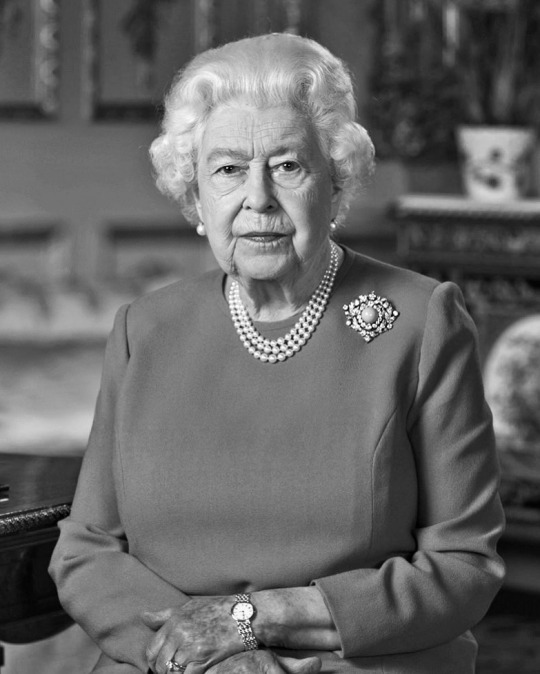
His Serene Highness The Count of Münnich and Reutern is deeply saddened to learn of the passing of Her Majesty Queen Elizabeth II.
The Count joins the Family and the people around the world in mourning profoundly the passing of a cherished Sovereign and a much loved family relation.
The Queen was hugely admired for Her devotion, commitment to public service, and incredible leadership throughout Her remarkable 70-year reign.
Her Majesty's extraordinary legacy and influence will live on forever and She will be missed immensely.
#HM the Queen#hm queen elizabeth ii#Queen Elizabeth II#His Excellency The Count of Reutern#Joshua Edward Dylan Wood#Josh Wood#Joshua Wood#Joshua Dylan Wood#The Count of Reutern#royal cousins#Her Majesty Queen Elizabeth II#rest in peace your majesty#Count Joshua von Münnich#Count Joshua von Reutern#Count Joshua von Munnich-Reutern#Mourning#Elizabeth Alexandra Mary Windsor#Elizabeth Alexandra Mary York#House of Windsor#elizabeth alexandra mary#Mountbatten#mountbatten-windsor#Saxe-Coburg and Gotha#Saxe-Coburg-Gotha#Schleswig-Holstein-Sonderburg-Glücksburg#british royal family#royal families of europe#His Excellency Sir Joshua Dylan Wood The Count of Reutern KAN KWE GCSTA GCSTS#The Count of Munnich-Reutern#His Excellency The Count of Munnich-Reutern
2 notes
·
View notes
Photo

Happy Birthday, Queen Elizabeth II (21 April 1926)! Born Elizabeth Alexandra Mary, she became Queen Elizabeth II on 6 February 1952 and her coronation was 2 June 1953, where she became Queen of the United Kingdom and 15 other Commonwealth realms (currently).
#birthday#Queen Elizabeth II#Elizabeth Alexandra Mary#Princess Elizabeth of York#mother#United Kingdom#England#coronation#marriage#Prince Philip Duke of Edinburgh#family#beauty#strength#House of Windsor#George VI#Elizabeth Bowes-Lyon#royalty#monarch#95 years old#Elizabeth II
79 notes
·
View notes
Photo

Queen Victoria’s Bow Brooches ♕ King Charles III
#queen elizabeth#queen elizabeth ii#queen elizabeth the queen mother#elizabeth bowes lyon#the queen mother#queen mother#mary of teck#queen mary#queen alexandra#Queen Victoria#bow brooch#bow jewelry#diamond brooch#Diamond Jewelry#diamond jewels#Duchess of Edinburgh#british royal family#british royal jewels#Windsor#House of Windsor#windsor royal family#Windsor Royal Jewels#Queen Elizabeth Brooches#Queen Elizabeth Brooch#personal property#personal jewelry#Queen Elizabeth Personal Property#Queen Elizabeth Personal Jewelry#royal jewels#inherited jewels
89 notes
·
View notes
Photo





❃ ✯ ❃ Ten Favorites ❃ ✯ ❃
British Bracelets and Brooches
7. Cullinan III & IV Brooch
#ten favorites#queen elizabeth#queen elizabeth ii#queen mary#queen alexandra#Cullinan Diamonds#Cullinan III & IV Brooch#Cullinan Brooch#diamond brooch#Diamond Jewelry#diamond jewels#british jewels#personal property#personal jewelry#british royal family#british royal jewels#Windsor#House of Windsor#royal jewels
24 notes
·
View notes
Photo

19 September 2022 | Princess Beatrice looks emotional as she follows the cortège of the late Queen Elizabeth II as it is pulled past the Houses of Parliament after her funeral at Westminster Abbey in London, England. Elizabeth Alexandra Mary Windsor was born in Bruton Street, Mayfair, London on 21 April 1926. She married Prince Philip in 1947 and ascended the throne of the United Kingdom and Commonwealth on 6 February 1952 after the death of her Father, King George VI. Queen Elizabeth II died at Balmoral Castle in Scotland on September 8, 2022, and is succeeded by her eldest son, King Charles III. (c) Joshua Bratt- WPA Pool/Getty Images
94 notes
·
View notes
Photo
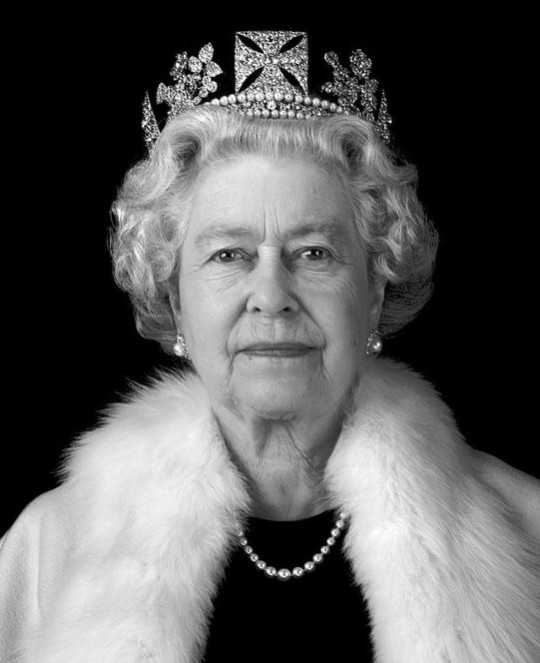
The long reign of Queen Elizabeth II was marked by her strong sense of duty and her determination to dedicate her life to her throne and to her people.
She became for many the one constant point in a rapidly changing world as British influence declined, society changed beyond recognition and the role of the monarchy itself came into question.
Her success in maintaining the monarchy through such turbulent times was even more remarkable given that, at the time of her birth, no-one could have foreseen that the throne would be her destiny.
Elizabeth Alexandra Mary Windsor was born on 21 April 1926, in a house just off Berkeley Square in London, the first child of Albert, Duke of York, second son of George V, and his duchess, the former Lady Elizabeth Bowes-Lyon.
Both Elizabeth and her sister, Margaret Rose, who was born in 1930, were educated at home and brought up in a loving family atmosphere. Elizabeth was extremely close to both her father and her grandfather, George V.
At the age of six, Elizabeth told her riding instructor that she wanted to become a "country lady with lots of horses and dogs".
She was said to have shown a remarkable sense of responsibility from a very early age. Winston Churchill, the future prime minister, was quoted as saying that she possessed "an air of authority that was astonishing in an infant".
Despite not attending school, Elizabeth proved adept at languages and made a detailed study of constitutional history.
A special Girl Guides company, the 1st Buckingham Palace, was formed so that she could socialise with girls of her own age.
Increasing tension
On the death of George V in 1936, his eldest son, known as David, became Edward VIII.
However, his choice of wife, the twice-divorced American Wallis Simpson, was deemed to be unacceptable on political and religious grounds. At the end of the year he abdicated.
A reluctant Duke of York became King George VI. His Coronation gave Elizabeth a foretaste of what lay in store for her and she later wrote that she had found the service "very, very wonderful".
Against a background of increasing tension in Europe, the new King, together with his wife, Queen Elizabeth, set out to restore public faith in the monarchy. Their example was not lost on their elder daughter.
In 1939, the 13-year-old princess accompanied the King and Queen to the Royal Naval College at Dartmouth.
Together with her sister Margaret, she was escorted by one of the cadets, her third cousin, Prince Philip of Greece.
Obstacles
It was not the first time they had met, but it was the first time she took an interest in him.
Prince Philip called on his royal relatives when on leave from the navy, and by 1944, when she was 18, Elizabeth was clearly in love with him. She kept his picture in her room and they exchanged letters.
The young princess briefly joined the Auxiliary Territorial Service (ATS) towards the end of the war, learning to drive and service a lorry. On VE Day, she joined the Royal Family at Buckingham Palace as thousands gathered in The Mall to celebrate the end of the war in Europe.
"We asked my parents if we could go out and see for ourselves," she later recalled. "I remember we were terrified of being recognised. I remember lines of unknown people linking arms and walking down Whitehall, all of us just swept along on a tide of happiness and relief."
After the war, her desire to marry Prince Philip faced a number of obstacles.
The King was reluctant to lose a daughter on whom he doted, and Philip had to overcome the prejudice of an establishment that could not accept his foreign ancestry.
But the wishes of the couple prevailed and on 20 November 1947 the couple married in Westminster Abbey.
The Duke of Edinburgh, as Philip had become, remained a serving naval officer. For a short time, a posting to Malta meant the young couple could enjoy a relatively normal life.
Their first child, Charles, was born in 1948, followed by a sister, Anne, who arrived in 1950.
But the King, having suffered considerable stress during the war years, was terminally ill with lung cancer, brought about by a lifetime of heavy smoking.
In January 1952, Elizabeth, then 25, set off with Philip for an overseas tour. The King, against medical advice, went to the airport to see the couple off. It was to be the last time Elizabeth would see her father.
Elizabeth heard of the death of the King while staying at a game lodge in Kenya and the new Queen immediately returned to London.
"In a way, I didn't have an apprenticeship," she later recalled. "My father died much too young, so it was all a very sudden kind of taking on and making the best job you can."
Personal attack
Her Coronation in June 1953 was televised, despite the opposition of Prime Minister Winston Churchill, and millions gathered around TV sets, many of them for the first time, to watch as Queen Elizabeth II made her oath.
With Britain still enduring post-war austerity, commentators saw the Coronation as the dawn of a new Elizabethan age.
World War Two had served to hasten the end of the British Empire, and by the time the new Queen set off on a lengthy tour of the Commonwealth in November 1953, many former British possessions, including India, had gained independence.
Elizabeth became the first reigning monarch to visit Australia and New Zealand. It was estimated that three-quarters of Australians turned out to see her in person.
Throughout the 1950s, more countries hauled down the union flag and the former colonies and dominions now came together as a voluntary family of nations.
Many politicians felt that the new Commonwealth could become a counter to the newly emerging European Economic Community and, to some extent, British policy turned away from the Continent.
But the decline of British influence was hastened by the Suez debacle in 1956, when it became clear that the Commonwealth lacked the collective will to act together in times of crisis. The decision to send British troops to try to prevent Egypt's threatened nationalisation of the Suez Canal ended in an ignominious withdrawal and brought about the resignation of Prime Minister Anthony Eden.
This embroiled the Queen in a political crisis. The Conservative Party had no mechanism for electing a new leader and, after a series of consultations, the Queen invited Harold Macmillan to form a new government.
The Queen also found herself the subject of a personal attack by the writer Lord Altrincham. In a magazine article, he claimed her court was "too British" and "upper-class" and accused her of being unable to make a simple speech without a written text.
His remarks caused a furore in the press and Lord Altrincham was physically attacked in the street by a member of the League of Empire Loyalists.
Nevertheless, the incident demonstrated that British society and attitudes to the monarchy were changing fast and old certainties were being questioned.
From 'the Monarchy' to 'the Royal Family'
Encouraged by her husband, notoriously impatient with the court's stuffiness, the Queen began to adapt to the new order.
The practice of receiving debutantes at court was abolished and the term "the Monarchy" was gradually replaced by "the Royal Family".
The Queen was once more at the centre of a political row when in 1963, Harold Macmillan stood down as prime minister. With the Conservative Party still to set up a system for choosing a new leader, she followed his advice to appoint the Earl of Home in his place.
It was a difficult time for the Queen. The hallmark of her reign was constitutional correctness, and a further separation of the monarchy from the government of the day. She took seriously her rights to be informed, to advise and to warn - but did not seek to step beyond them.
It was to be the last time she would be put in such a position. The Conservatives finally did away with the tradition that new party leaders just "emerged", and a proper system was put in place.
By the late 1960s, Buckingham Palace had decided that it needed to take a positive step to show the Royal Family in a far less formal and more approachable way.
The result was a ground-breaking documentary, Royal Family. The BBC was allowed to film the Windsors at home. There were pictures of the family at a barbecue, decorating the Christmas tree, taking their children for a drive - all ordinary activities, but never seen before.
Critics claimed that Richard Cawston's film destroyed the mystique of the royals by showing them to be ordinary people, including scenes of the Duke of Edinburgh barbecuing sausages in the grounds at Balmoral.
But the film echoed the more relaxed mood of the times and did much to restore public support for the monarchy.
By 1977, the Silver Jubilee was celebrated with genuine enthusiasm in street parties and in ceremonies across the kingdom. The monarchy seemed secure in the public's affection and much of that was down to the Queen herself.
Two years later, Britain had, in Margaret Thatcher, its first woman prime minister. Relations between the female head of state and female head of government were sometimes said to have been awkward.
Scandals and disasters
One difficult area was the Queen's devotion to the Commonwealth, of which she was head. The Queen knew the leaders of Africa well and was sympathetic to their cause.
She was reported to have found Thatcher's attitude and confrontational style "puzzling", not least over the prime minister's opposition to sanctions against apartheid South Africa.
Year by year, the Queen's public duties continued. After the Gulf War in 1991, she went to the United States to become the first British monarch to address a joint session of Congress. President George HW Bush said she had been "freedom's friend for as long as we can remember".
However, a year later, a series of scandals and disasters began to affect the Royal Family.
The Queen's second son, the Duke of York, and his wife Sarah separated, while Princess Anne's marriage to Mark Phillips ended in divorce. Then the Prince and Princess of Wales were revealed to be deeply unhappy and eventually split up.
The year culminated in a huge fire at the Queen's favourite residence, Windsor Castle. It seemed a grimly appropriate symbol of a royal house in trouble. It was not helped by a public row over whether the taxpayer, or the Queen, should foot the bill for the repairs.
The Queen described 1992 as her "annus horribilis" and, in a speech in the City of London, appeared to concede the need for a more open monarchy in return for a less hostile media.
"No institution, city, monarchy, whatever, should expect to be free from the scrutiny of those who give it their loyalty and support, not to mention those who don't. But we are all part of the same fabric of our national society and that scrutiny can be just as effective if it is made with a measure of gentleness, good humour and understanding."
The institution of monarchy was very much on the defensive. Buckingham Palace was opened to visitors to raise money to pay for the repairs at Windsor and it was announced that the Queen and the Prince of Wales would pay tax on investment income.
Abroad, the hopes for the Commonwealth, so high early in her reign, had not been fulfilled. Britain had turned its back on its old partners with new arrangements in Europe.
The Queen still saw value in the Commonwealth and was deeply gratified when South Africa, where she had come of age, at last threw apartheid aside. She celebrated with a visit in March 1995.
At home, the Queen sought to maintain the dignity of the monarchy while public debate continued on whether the institution had any future.
Death of Diana, Princess of Wales
As Britain struggled to find a new destiny, she tried to remain a reassuring figure, and with a sudden smile could lighten a solemn moment. The role she valued above all was that of symbol of the nation.
However, the monarchy was shaken and the Queen herself attracted unusual criticism after the death of Diana, Princess of Wales, in a car accident in Paris in August 1997.
As the public crowded around the palaces in London with tributes of flowers, the Queen seemed reluctant to provide the focus that she had always tried to do during great national moments.
Many of her critics failed to understand that she was from a generation that recoiled from the almost hysterical displays of public mourning that typified the aftermath of the princess's death.
She also felt as a caring grandmother that she needed to comfort Diana's sons in the privacy of the family circle.
Eventually, she made a live broadcast, paying tribute to her daughter-in-law and making a commitment that the monarchy would adapt.
Losses and celebrations
The deaths of the Queen Mother and Princess Margaret, in the Queen's Golden Jubilee year, 2002, cast a shadow over nationwide celebrations of her reign.
But despite this, and the recurring debate over the future of the monarchy, a million people crowded into The Mall, in front of Buckingham Palace, on the evening of the jubilee.
In April 2006, thousands of well-wishers lined the streets of Windsor as the Queen performed an informal walkabout on her 80th birthday.
And in November 2007, she and Prince Philip celebrated 60 years of marriage with a service attended by 2,000 people at Westminster Abbey.
There was yet another happy occasion in April 2011 when the Queen attended the wedding of her grandson, William, Duke of Cambridge, to Catherine Middleton.
In May that year she became the first British monarch to make an official visit to the Irish Republic, an event of great historical significance.
In a speech, which she began in Irish, she called for forbearance and conciliation and referred to "things we wish had been done differently or not at all".
Referendum
A year later, on a visit to Northern Ireland as part of the Diamond Jubilee celebrations, she shook hands with the former IRA commander Martin McGuinness.
It was a poignant moment for a monarch whose much-loved cousin, Lord Louis Mountbatten, had been killed by an IRA bomb in 1979.
The Diamond Jubilee brought hundreds of thousands of people on to the streets and culminated in a weekend of celebrations in London.
The referendum on Scottish independence, in September 2014, was a testing time for the Queen. Few had forgotten her speech to Parliament in 1977 in which she made clear her commitment to a United Kingdom.
"I number kings and queens of England and of Scotland, and princes of Wales among my ancestors and so I can readily understand these aspirations. But I cannot forget that I was crowned Queen of the United Kingdom of Great Britain and Northern Ireland."
In a remark to well-wishers at Balmoral on the eve of the Scottish referendum, which was overheard, she said she hoped people would think very carefully about the future.
Once the result of the vote was known, her public statement underlined the relief she felt that the Union was still intact, although recognising that the political landscape had changed.
"Now, as we move forward, we should remember that despite the range of views that have been expressed, we have in common an enduring love of Scotland, which is one of the things that helps to unite us all."
On 9 September 2015 she became the longest reigning monarch in British history, surpassing the reign of her great-great-grandmother Queen Victoria. In typical style she refused to make any fuss saying the title was "not one to which I have ever aspired".
Less than a year later, in April 2016, she celebrated her 90th birthday.
She continued with her public duties, often alone after the retirement of the Duke of Edinburgh in 2017.
There were continued strains on the family - including her husband's car accident, the Duke of York's ill-judged friendship with convicted American businessman Jeffrey Epstein and Prince Harry's growing disillusionment with life in the royal family.
These were unsettling moments, presided over by a monarch who demonstrated that she was still firmly in control. There was also the death of Prince Philip in April 2021, in the midst of the coronavirus pandemic, and her Platinum Jubilee a year later.
Although the monarchy might not have been as strong at the end of the Queen's reign as it was at the start, she was determined that it should continue to command a place of affection and respect in the hearts of the British people.
On the occasion of her Silver Jubilee, she recalled the pledge she had made on a visit to South Africa 30 years before.
"When I was 21, I pledged my life to the service of our people and I asked for God's help to make good that vow. Although that vow was made in my salad days, when I was green in judgement, I do not regret, or retract, one word of it."
Daily inspiration. Discover more photos at http://justforbooks.tumblr.com
100 notes
·
View notes
Text





On 30 June 1978, Prince Michael of Kent, the younger brother the Duke of Kent, wed Baroness Marie Christine von Reibnitz. ... Prince Michael of Kent and Marie-Christine von Reibnitz married in a civil ceremony at Vienna's Rathaus (City Hall) in Austria.
Michael is the paternal first cousin of Queen Elizabeth II, and Marie Christine is of German, Austrian and Hungarian noble descent. She is the only daughter of Silesian nobleman Baron Gunther von Reibnitz and his Austro-Hungarian wife, Countess Maria Szapáry de Muraszombath.
The marriage made headlines at the time because Marie Christine von Reibnitz was not only a Roman Catholic but also a divorcée. Marie Christine was previously married to banker Thomas Troubridge, and the two separated in 1973 and divorced in 1977. The marriage was annulled by the Roman Catholic Church a year later and just two weeks before she married Prince Michael.
Michael proposed to Marie Christine with a two-stone sapphire-and-diamond ring with a very personal touch. It was made from gems that belonged to his late mother, Princess Marina, Duchess of Kent (who was born a princess of Greece and Denmark).
Prince Michael of Kent and Marie-Christine von Reibnitz married in a civil ceremony at Vienna’s Rathaus (City Hall) in Austria. However, royal representation was limited. The groom’s brother, the Duke of Kent, and his sister, Princess Alexandra, attended as did Princess Anne and Lord Mountbatten. The couple later received a blessing of their marriage in a Roman Catholic ceremony on 29 June 1983 at the Archbishop’s House in London.
For the reception held after the wedding, Marie Christine wore the City of London Fringe Tiara and a 70s style dress. Upon marriage, she was accorded the style and title of Her Royal Highness Princess Michael of Kent, the female equivalent of her husband’s title.
Under the Act of Settlement 1701, a bill passed by Parliament ensuring that only Protestants could ascend to the throne, Michael forfeited his place in line of succession to marry a Roman Catholic. However, the Prince was later reinstated after the Succession to the Crown Act 2013. This bill altered the laws of succession to the throne and famously ensured that the eldest child, regardless of sex, precedes his or her younger brothers and sisters.

Prince and Princess of Michael of Kent’s children are members of the Church of England and have been in the line of succession since birth. Lord Frederick Windsor was born 6 April 1979 at St Mary’s Hospital in London; his sister, Lady Gabriella Kingston, was born at the same hospital on 23 April 1981.

Lady Gabriella Marina Alexandra Ophelia Kingston (née Windsor; born 23 April 1981) is an English freelance writer and a member of the British royal family. She is the daughter of Prince and Princess Michael of Kent. She is 55th in the line of succession to the British throne.
Lord Frederick Michael George David Louis Windsor (born 6 April 1979) is a British financial analyst, and the only son of Prince and Princess Michael of Kent. He is married to British actress Sophie Winkleman. He is currently 52nd in the line of succession to the British throne. He is president of Soldier On!, a charity for the professional development of vulnerable and disadvantaged people.

15 notes
·
View notes
Text

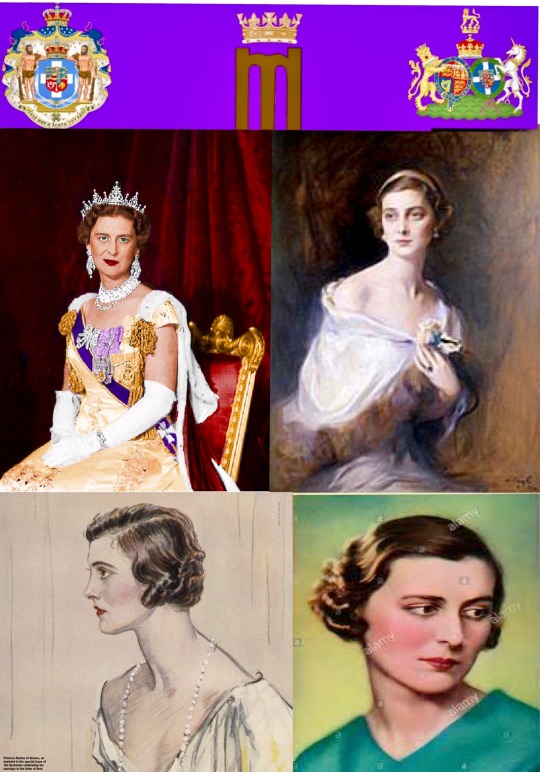
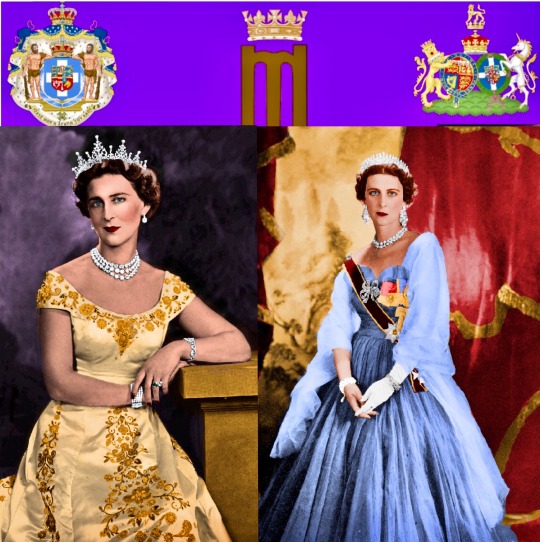

Funeral of Princess Marina, Duchess of Kent at St George’s Chapel, Windsor Castle on this day in 1968. The service was conducted by the Archbishop of Canterbury and the Archimandrite of the Greek Orthodox Church. The princess’ coffin was carried into and out of the Chapel by eight officers from the three regiments of which she was Colonel-in-Chief
Royal attendees included the Duke of Kent, Duchess of Kent, Princess Alexandra, Sir Angus Ogilvy, Prince Michael, the Queen, Duke of Edinburgh, the Queen Mother, Prince of Wales, Princess Royal, Princess Margaret, the Duke and Duchess of Gloucester, and the Duke of Windsor, as well as members of the Greek, Danish, and Yugoslavian Royal Families.
Princess Marina was born on 13 December 1906 in Athens, Greece, during the reign of her paternal grandfather, George I of Greece. She was the third and youngest daughter of Prince Nicholas of Greece and Denmark, and his wife Grand Duchess Elena Vladimirovna of Russia.Her father was the third son of George I of Greece and Queen Olga,while her mother was the only daughter of Grand Duke Vladimir Alexandrovich and Grand Duchess Maria Pavlovna of Russia. Her father was a grandson of Christian IX of Denmark, while her mother was a granddaughter of
Emperor Alexander II of Russia.
Princess Marina had two elder sisters, Princess Olga and Princess Elizabeth of Greece and Denmark .
One of her first cousins was Prince Philip (later the Duke of Edinburgh), who married her niece, the future Queen Elizabeth II, in 1947.
Princess Marina of Greece and Denmark, later Duchess of Kent; 13 December was a princess of the Greek royal house, who married Prince George, Duke of Kent, fourth son of George V and Queen Mary, in 1934. They had three children: Prince Edward, Princess Alexandra, and Prince Michael.
The Princess was widowed in 1942, when her husband was killed in a plane crash on active service. In later life she carried out many royal engagements, including the independence celebrations for Ghana and Botswana.
She served as the first Chancellor of the University of Kent at Canterbury from 1963 until her death from a brain tumour at Kensington Palace at 11.40 am on 27 August 1968, aged 61. Funeral service for the Princess was held at the St. George's Chapel on 30 August.She was buried in the Royal Burial Ground, Frogmore. Her funeral was the final royal ceremony attended by her brother-in-law, the former Edward VIII
Κηδεία της πριγκίπισσας Μαρίνας, Δούκισσας του Κεντ στο Παρεκκλήσι του Αγίου Γεωργίου, το Κάστρο του Ουίνδσορ, σαν σήμερα το 1968. Η λειτουργία τελέστηκε από τον Αρχιεπίσκοπο του Καντέρμπερι και τον Αρχιμανδρίτη της Ελληνικής Ορθόδοξης Εκκλησίας. Το φέρετρο της πριγκίπισσας μεταφέρθηκε μέσα και έξω από το Παρεκκλήσι από οκτώ αξιωματικούς από τα τρία συντάγματα των οποίων ήταν αρχισυνταγματάρχης
Οι βασιλικοί παρευρισκόμενοι ήταν ο δούκας του Κεντ, η δούκισσα του Κεντ, η πριγκίπισσα Αλεξάνδρα, ο Σερ Άνγκους Όγκιλβι, ο πρίγκιπας Μιχάηλ , η βασίλισσα, ο δούκας του Εδιμβούργου, η βασίλισσα μητέρα, ο πρίγκιπας της Ουαλίας, η πριγκίπισσα Βασιλική, η πριγκίπισσα Μάργκαρετ, ο δούκας και η δούκισσα του Γκλόστερ, και ο Δούκας του Ουίνδσορ, καθώς και μέλη της ελληνικής, της δανικής και της γιουγκοσλαβικής βασιλικής οικογένειας.
Η πριγκίπισσα Μαρίνα γεννήθηκε στις 13 Δεκεμβρίου 1906 στην Αθήνα, κατά τη διάρκεια της βασιλείας του παππού της, Γεωργίου Α 'της Ελλάδας. Ήταν η τρίτη και νεότερη κόρη του πρίγκιπα Νικολάου της Ελλάδας και της Δανίας και της συζύγου του Μεγάλης Δούκισσας Έλενας Βλαντιμιρόβνα της Ρωσίας. Ο πατέρας της ήταν ο τρίτος γιος του Γεωργίου Α της Ελλάδας και της βασίλισσας Όλγας, ενώ η μητέρα της ήταν η μοναχοκόρη του Μεγάλου Δούκα Βλαντιμίρ Αλεξάντροβιτς και η Μεγάλη Δούκισσα Μαρία Παβλόβνα της Ρωσίας. Ο πατέρας της ήταν εγγονός του Χρηστιανου Θ’της Δανίας, ενώ η μητέρα της ήταν εγγονή του
Αυτοκράτορα Αλέξανδρου Β’της Ρωσίας.
Η πριγκίπισσα Μαρίνα είχε δύο μεγαλύτερες αδελφές, την πριγκίπισσα Όλγα και την πριγκίπισσα Ελισάβετ της Ελλάδας και της Δανίας.
Ένας από τους πρώτους ξαδέλφους της ήταν ο πρίγκιπας Φίλιππος (αργότερα δούκας του Εδιμβούργου), ο οποίος παντρεύτηκε την ανιψιά της, τη μελλοντική βασίλισσα Ελισάβετ Β, το 1947.
Πριγκίπισσα Μαρίνα της Ελλάδας και της Δανίας, αργότερα Δούκισσα του Κεντ. Η 13η Δεκεμβρίου ήταν όταν μια πριγκίπισσα του ελληνικού βασιλικού οίκου, παντρεύτηκε τον πρίγκιπα Γεώργιο, δούκα του Κεντ, τέταρτο γιο του Γεωργίου Ε’ και της βασίλισσας Μαρίας, το 1934. Απέκτησαν τρία παιδιά: τον πρίγκιπα Εδουάρδο, την πριγκίπισσα Αλεξάνδρα και τον πρίγκιπα Μιχαήλ.
Η πριγκίπισσα έμεινε χήρα το 1942, όταν ο σύζυγός της σκοτώθηκε σε αεροπορικό δυστύχημα σε ενεργό υπηρεσία. Στη μετέπειτα ζωή της πραγματοποίησε πολλές βασιλικές εκδήλωσεις , συμπεριλαμβανομένων των εορτασμών ανεξαρτησίας για τη Γκάνα και τη Μποτσουάνα.
Υπηρέτησε ως η πρώτη Πρυτανης του Πανεπιστημίου του Κεντ στο Καντέρμπουρυ από το 1963 μέχρι τον θάνατό της από όγκο στον εγκέφαλο στο Παλάτι του Κένσινγκτον στις 11.40 π.μ. στις 27 Αυγούστου 1968, σε ηλικία 61 ετών. Η κηδεία της πριγκίπισσας έγινε στο παρεκκλήσι του Αγίου Γεωργίου στις 30 Αυγούστου. Τάφηκε στο Royal Burial Ground, Frogmore. Η κηδεία της ήταν η τελευταία βασιλική τελετή στην οποία συμμετείχε ο κουνιάδος της, ο πρώην Εδουάρδος Η’
#kingconstantine#danishroyalfamily#crownprincepavlos#queenannemarie#greek royal family#house of romanov#princess theodora#princessmarieolympia#crownprincessmariechantal#princeachileasandreas#princeconstantinealexios#princenikolaos#princesstatiana#princefilippos
7 notes
·
View notes
Photo






your royal highnesses, the house of windsor! ━ part one
com a coroa residindo sobre a cabeça de elizabeth ii, a família windsor é conhecida mundialmente como a monarquia do reino unido - que inclui também outros quinze estados independentes -, apesar do sistema político atual contar com o poder de governo sendo cedido pela monarquia ao primeiro ministro.
ainda que sempre sob os holofotes e o foco da mídia, os windsor ainda são uma família normal, e aqui você encontra um pouco mais sobre eles...
+ part two
@gg-pontos
1. príncipe edward louis clarke, príncipe consorte do reino unido (dick van dyke) ━ nascido em londres em 13 de fevereiro de 1923, edward atualmente tem 98 anos de idade. descendente de família nobre e próxima dos windsor, edward seguiu carreira militar, tendo inclusive participado da segunda guerra mundial. conhecia elizabeth desde a infância, não tendo sido grande surpresa quando envolveram-se romanticamente, no que resultou em edward recebendo o título de duque de edimburgo e, posteriormente ao que elizabeth ii foi coroada rainha, o título de príncipe consorte. com elizabeth teve dois filhos: edward ii e arthur.
2. rainha elizabeth alexandra mary windsor, rainha do reino unido (betty white) ━ fruto da união do rei george vi e da rainha elizabeth, nasceu em londres em 6 de fevereiro de 1926. em 1947, casou-se com edward, o duque de edimburgo, seu amor de infância, e com ele teve dois filhos: edward ii e arthur. primogênita, elizabeth ii herdou o trono após a morte de seu pai e abdicação de seu tio em 1952, sendo coroada em 1953 e regendo até o presente momento, aos 95 anos de idade.
3. príncipe edward alexander douglas windsor, primeiro na linha de sucessão ao trono (pierce brosnan) ━ primogênito de elizabeth ii e edward, edward ii nasceu em londres no dia 27 de abril de 1954. formou-se em direito pela universidade de cambridge, onde conheceu sua atual esposa, grace, com quem teve dois filhos: phillip e charlotte. adorado pelo povo, o duque de cambridge atualmente tem 67 anos e é o sucessor direto de elizabeth ii ao trono.
4. princesa grace anne windsor (née coleman), duquesa de cambridge (michelle pfeiffer) ━ nascida em belfast em 30 de julho de 1960, grace conheceu o príncipe edward ii enquanto estudava direito na universidade de cambridge. noiva de edward ii, foi nomeada duquesa de cambridge, e com o casamento, tornou-se uma princesa do reino unido. grace tem 61 anos e é mãe de phillip e charlotte.
5. príncipe phillip andrew george windsor, segundo na linha de sucessão ao trono (alex pettyfer) ━ nascido em londres em 19 de janeiro de 1989, é o primogênito da união entre o príncipe edward ii e grace. aos 32 anos segue carreira médica militar e não raramente tem relacionamentos amorosos especulados pela mídia, levantando suspeitas sobre a nova princesa. apesar de ser bastante reservado quanto à sua vida pessoal, é bastante querido pelo povo por ter sido o primeiro de sua geração.
6. princesa charlotte elizabeth grace windsor, terceira na linha de sucessão ao trono (florence pugh) ━ segunda filha do príncipe edward ii e de grace, a irmã mais nova de phillip veio ao mundo em 5 de maio de 1997. é conhecida mundialmente por suas amizades com outras pessoas famosas - incluindo sua prima catherine - e ao contrário do irmão, tem a vida pessoal acompanhada pela mídia. atualmente tem 24 anos e está em seu primeiro ano de literatura inglesa na universidade de oxford.
#g&gpontos#something in the way you're looking through my eyes ➤ 𝒅𝒆𝒗𝒆𝒍𝒐𝒑𝒎𝒆𝒏𝒕 .#you're looking at me like you don't know who I am ➤ 𝒂𝒃𝒐𝒖𝒕 .#family
6 notes
·
View notes